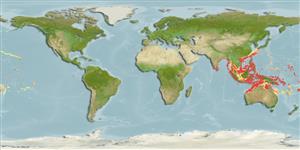Teleostei (teleosts) >
Carangiformes (Jacks) >
Carangidae (Jacks and pompanos) > Caranginae
Etymology: Selar: A Malay vernacular name, ikan selar.
More on author: Cuvier.
Environment: milieu / climate zone / depth range / distribution range
Ecology
Marine; reef-associated; depth range 35 - 500 m (Ref. 4233). Subtropical; 31°N - 23°S, 75°E - 134°W
Pacific Ocean: Andaman Islands to Vanuatu, north to the Philippines, south to northern Australia.
Size / Weight / Age
Maturity: Lm ? range ? - ? cm
Max length : 25.0 cm FL male/unsexed; (Ref. 4233); common length : 22.0 cm FL male/unsexed; (Ref. 4233)
Adults are found inshore and form large schools on day time. They disperse at night to feed on planktonic and benthic invertebrates such as crabs and shrimps. Eggs are pelagic (Ref. 4233, 7300, 90102).
Life cycle and mating behavior
Maturity | Reproduction | Spawning | Eggs | Fecundity | Larvae
Paxton, J.R., D.F. Hoese, G.R. Allen and J.E. Hanley, 1989. Pisces. Petromyzontidae to Carangidae. Zoological Catalogue of Australia, Vol. 7. Australian Government Publishing Service, Canberra, 665 p. (Ref. 7300)
IUCN Red List Status (Ref. 130435: Version 2025-1)
Threat to humans
Harmless
Human uses
Fisheries: commercial
Tools
Special reports
Download XML
Internet sources
Estimates based on models
Preferred temperature (Ref.
123201): 13.4 - 26.5, mean 20.4 °C (based on 400 cells).
Phylogenetic diversity index (Ref.
82804): PD
50 = 0.7500 [Uniqueness, from 0.5 = low to 2.0 = high].
Bayesian length-weight: a=0.01585 (0.00926 - 0.02712), b=3.03 (2.89 - 3.17), in cm total length, based on LWR estimates for this species & (Sub)family-body (Ref.
93245).
Trophic level (Ref.
69278): 3.5 ±0.41 se; based on food items.
Resilience (Ref.
120179): High, minimum population doubling time less than 15 months (K=1.90).
Fishing Vulnerability (Ref.
59153): Low vulnerability (18 of 100).
🛈
Nutrients (Ref.
124155): Calcium = 105 [35, 303] mg/100g; Iron = 1.82 [0.58, 4.51] mg/100g; Protein = 20.9 [18.6, 22.9] %; Omega3 = 0.411 [0.166, 1.033] g/100g; Selenium = 86.2 [24.7, 247.5] μg/100g; VitaminA = 11 [2, 60] μg/100g; Zinc = 1.17 [0.56, 2.14] mg/100g (wet weight);
